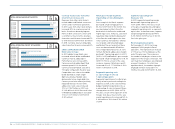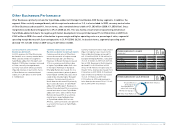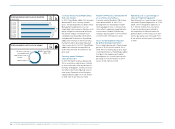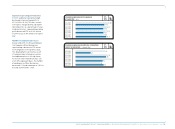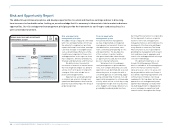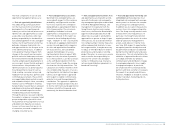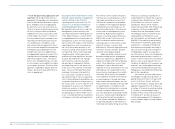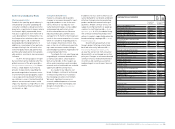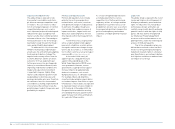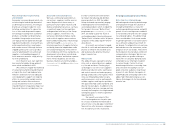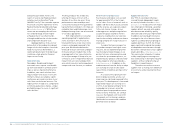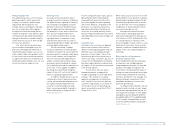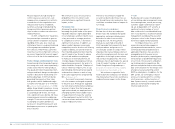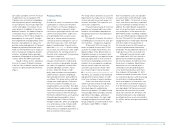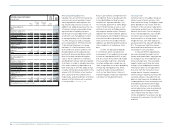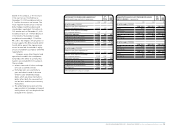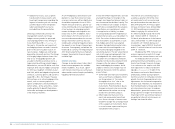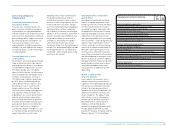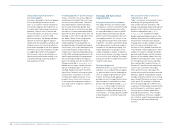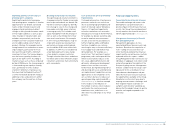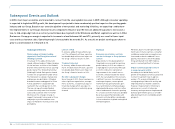Reebok 2009 Annual Report Download - page 150
Download and view the complete annual report
Please find page 150 of the 2009 Reebok annual report below. You can navigate through the pages in the report by either clicking on the pages listed below, or by using the keyword search tool below to find specific information within the annual report.
146 GROUP MANAGEMENT REPORT – FINANCIAL REVIEW Risk and Opportunity Report
During the past twelve months, the
launch of several new Reebok product
initiatives such as EasyTone™ and
JUKARI Fit to Fly™ has started to improve
the overall consumer experience for the
Reebok brand and rebuild brand image
see Reebok Strategy, p. 70. While these
results are encouraging, the risk from
loss of brand image remains higher
at Reebok than in our other brands,
although we believe the risk has moder-
ated compared to the prior year.
Aggregating these risks, we now
believe that in the medium term brand
image risk for the Group has a low likeli-
hood of occurrence. Nevertheless, a
significant deterioration in brand image
could have a high potential financial
impact on our Group.
Own-retail risks
New adidas, Reebok and Rockport
own-retail stores require considerable
up-front investment in furniture and fit-
tings as well as ongoing maintenance.
In addition, own-retail activities often
require longer-term lease or rent com-
mitments. Retail also employs signifi-
cantly more personnel in relation to net
sales than our wholesale business. The
higher portion of fixed costs compared to
our wholesale business implies a larger
profitability impact in cases of significant
sales declines.
The Group reduces this risk by only
entering into lease contracts with a
duration of less than ten years. Store
performance is measured by a retail
scorecard consisting of nine quantitative
key performance indicators. All shops are
ranked by their weighted average score.
Underperforming stores are restructured
or closed as appropriate.
With improvements in consumer
spending expected to lag behind eco-
nomic recovery in 2010, the risk of a
lower performance of our retail stores
remains unchanged compared to the
prior year. We therefore believe the
likelihood of major own-retail underper-
formance remains medium. Due to the
ongoing growth of our own-retail activi-
ties as a percentage of Group sales, we
continue to assess the potential financial
impact from own-retail underperform-
ance, which may also involve impairment
charges and store closures, as medium.
Risks from rising input costs
Raw material and labour costs account
for approximately 70% of the Group’s
cost of sales. Prices of materials such as
rubber, and those which closely correlate
with the oil price, are especially subject
to the risk of price changes. As our
ordering process and price negotiations
usually take place around six months
in advance of production, our sourcing
function has visibility and reaction time to
manage and plan for sharp increases in
input costs.
To reduce the financial impact on
our product margins from higher sourc-
ing costs, we are implementing further
lean manufacturing techniques at our
partner factories, eliminating time and
cost from the procurement process, re-
engineering our products and selectively
increasing prices where possible see
Global Operations, p. 88. In addition, in the
medium term we have the ability to adapt
our sourcing structure to take advan-
tage of more competitive pricing in other
locations.
As a result of the significant slow-
down of global economic activity, raw
material prices declined compared to the
prior year. This development is forecasted
to positively impact our sourcing costs
in 2010. As we begin planning for 2011,
renewed price increases cannot be
ruled out given the projected macroeco-
nomic recovery. Therefore, we continue
to assess the medium-term risks from
rising input costs as having a medium
likelihood of occurrence and a medium
potential financial impact.
Supplier default risks
Over 95% of our product offering is
sourced through independent suppli-
ers mainly located in Asia see Global
Operations, p. 88. To reduce the risk of busi-
ness interruptions following a potential
supplier default, we work with vendors
who demonstrate reliability, quality,
innovation and continuous improvement.
In addition, we have bought insurance
coverage for the risk of business inter-
ruptions caused by physical damage to
supplier premises. In 2009, the Group
again significantly reduced the number
of independent manufacturers through
the further rationalisation of our supplier
organisation see Global Operations, p. 88.
This exercise has allowed us to reduce
risk by simplifying our sourcing struc-
ture and focusing on the highest-quality
suppliers, without compromising our
flexibility or competitiveness.
Therefore, we continue to assess
supplier risks as having a low likelihood
of occurrence and a low potential finan-
cial impact.


